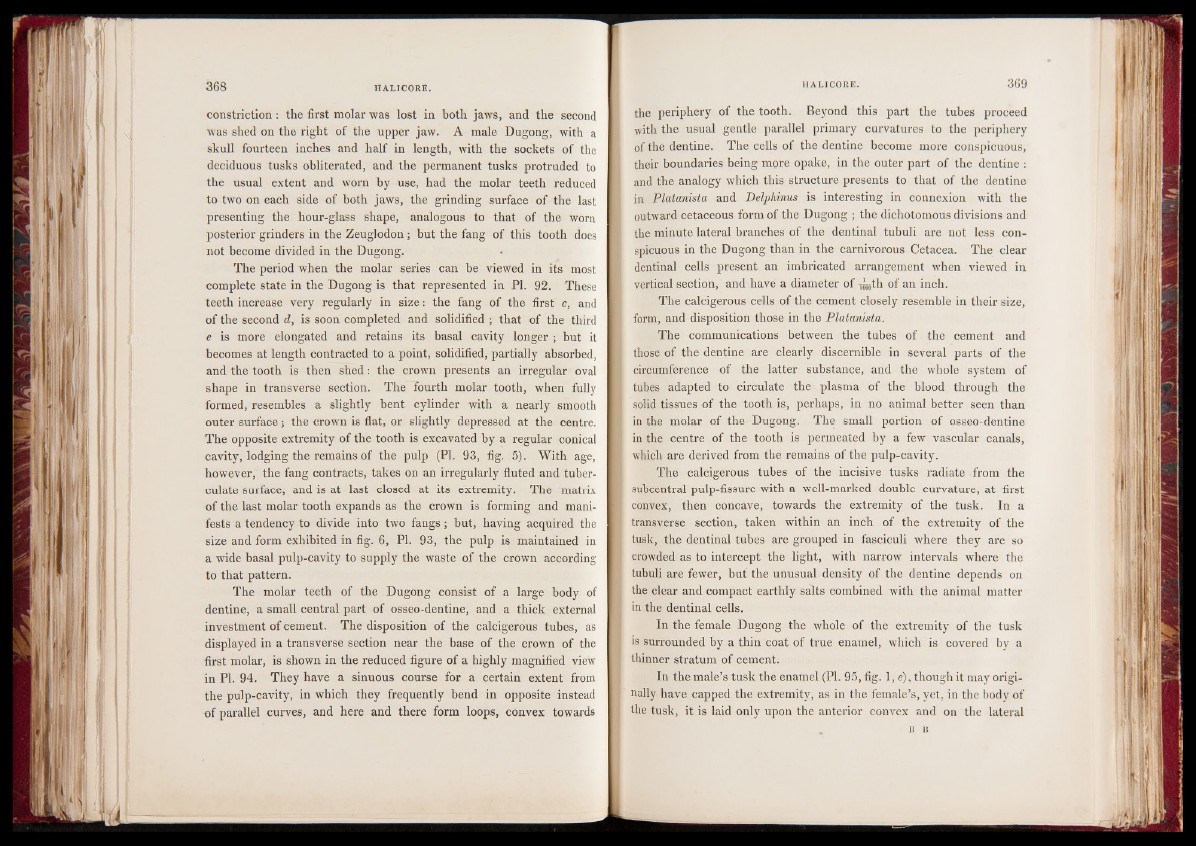
constriction : the first molar was lost in both jaws, and the second
was shed on the right of the upper jaw. A male Dugong, with a
skull fourteen inches and half in length, with the sockets of the
deciduous tusks obliterated, and the permanent tusks protruded to
the usual extent and worn by use, had the molar teeth reduced
to two on each side of both jaws, the grinding surface of the last
presenting the hour-glass shape, analogous to that of the worn
posterior grinders in the Zeuglodon ; but the fang of this tooth does
not become divided in the Dugong.
The period when the molar series can be viewed in its most
complete state in the Dugong is that represented in PI. 92. These
teeth increase very regularly in size: the fang of the first c, and
of the second d, is soon completed and solidified ; that of the third
e is more elongated and retains its basal cavity longer ; but it
becomes at length contracted to a point, solidified, partially absorbed,
and the tooth is then shed: the crown presents an irregular oval
shape in transverse section. The fourth molar tooth, when fully
formed, resembles a slightly bent cylinder with a nearly smooth
outer surface; the crown is flat, or slightly depressed at the centre.
The opposite extremity of the tooth is excavated by a regular conical
cavity, lodging the remains of the pulp (PI. 93, fig. 5). With age,
however, the fang contracts, takes on an irregularly fluted and tuber-
culate surface, and is at last closed at its extremity. The matrix
of the last molar tooth expands as the crown is forming and manifests
a tendency to divide into two fangs; but, having acquired the
size and form exhibited in fig. 6, PI. 93, the pulp is maintained in
a wide basal pulp-cavity to supply the waste of the crown according
to that pattern.
The molar teeth of the Dugong consist of a large body of
dentine, a small central part of osseo-dentine, and a thick external
investment of cement. The disposition of the calcigerous tubes, as
displayed in a transverse section near the base of the crown of the
first molar, is shown in the reduced figure of a highly magnified view
in PI. 94. They have a sinuous course for a certain extent from
the pulp-cavity, in which they frequently bend in opposite instead
of parallel curves, and here and there form loops, convex towards
the periphery of the tooth. Beyond this part the tubes proceed
with the usual gentle parallel primary curvatures to the periphery
of the dentine. The cells of the dentine become more conspicuous,
their boundaries being more opake, in the outer part of the dentine :
and the analogy which this structure presents to that of the dentine
in Platanista and Delphinus is interesting in connexion with the
outward cetaceous form of the Dugong ; the dichotomous divisions and
the minute lateral branches of the dentinal tubuli are not less conspicuous
in the Dugong than in the carnivorous Cetacea. The clear
dentinal cells present an imbricated arrangement when viewed in
vertical section, and have a diameter of ^ th of an inch.
The calcigerous cells of the cement closely resemble in their size,
form, and disposition those in the Platanista.
The communications between the tubes of the cement and
those of the dentine are clearly discernible in several parts of the
circumference of the latter substance, and the whole system of
tubes adapted to circulate the plasma of the blood through the
solid tissues of the tooth is, perhaps, in no animal better seen than
in the molar of the Dugong. The small portion of osseo-dentine
in the centre of the tooth is permeated by a few vascular canals,
which are derived from the remains of the pulp-cavity.
The calcigerous tubes of the incisive tusks radiate from the
subcentral pulp-fissure with a well-marked double curvature, at first
convex, then concave, towards the extremity of the tusk. In a
transverse section, taken within an inch of the extremity of the
tusk, the dentinal tubes are grouped in fasciculi where they are so
crowded as to intercept the light, with narrow intervals where the
tubuli are fewer, but the unusual density of the dentine depends on
the clear and compact earthly salts combined with the animal matter
in the dentinal cells.
In the female Dugong the whole of the extremity of the tusk
is surrounded by a thin coat of true enamel, which is covered by a
thinner stratum of cement.
In the male’s tusk the enamel (PI. 95, fig. 1, e), though it may originally
have capped the extremity, as in the female’s, yet, in the body of
the tusk, it is laid only upon the anterior convex and on the lateral